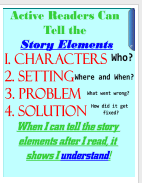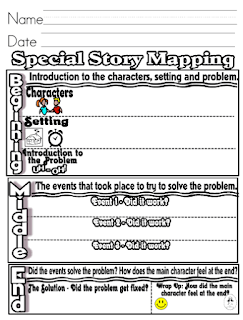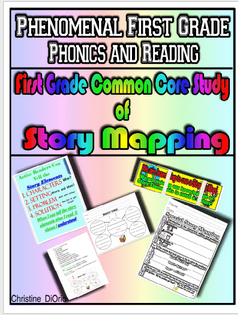 |
| Basic story map included. |
 |
| Anchor Chart included |
 |
| Special Story Map included. |
Here's what you get!
In this zipped file you receive everything you need to teach a Common Core Unit on studying Story Mapping in a first grade classroom. It’s a wrap up to our other Common Core Comprehension studies: The Setting, The Main Character and The Problem and Solution. This file includes lessons about generalized story mapping and then lesson plans on how to go deeper with story mapping. We call it Special Story Mapping.
There are seven different lesson plans set up in the Reader’s Workshop Model of minilesson, meeting, connection, teaching point, active engagement, independent reading, conferencing, and share. The lessons can be used from a 2 – 3 week period and done over more than one day. The ending of this unit transfers the students to completing independent projects and activities with their ‘just right’ books.
There are lessons for interactive read alouds to introduce and practice engaging students in the identification of the story elements in a story.
There is a list of mentor texts we have used and found success when studying story elements. Some are repeats from our other comprehension studies, but that is a good thing. We have found great success in using the same books, but looking at them with ‘different eyes’. The students grasp the concepts more easily when relating to a story they already know. You can always add any read alouds that you have already done as well, or choose new ones.
There are anchor charts already created for you that are colorful and engaging. The anchor charts is in a Smart Board File that is editable if you have a Smart Board. There are also hard pdf poster copies of the anchor charts that can be tile printed. Even if you have a Smart Board, these can be printed out to display. There are also copies of the anchor charts in an 8 ½ by 11” format if you’d like to reuse them in small group instruction or copy packets for your students to keep with them. There is one major anchor chart that starts the file. After that are two copies of the regular story map. After that are two copies of the Special Story Mapping. (See Lesson 5) their own work. The rubric can be printed in both 8 ½ by 11” or tile printed as a poster to hang in your classroom.
Also included in this file is a banner that can be used to display student work and two min posters that state the chants that can be posted in your room as reminders.
What’s great about this pack is it almost a ‘blank’ format for students to learn the content through. We have similar things for the other story elements so once the students learn this type of process, you can filter the content through.


No comments:
Post a Comment